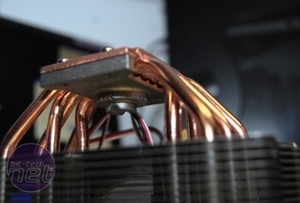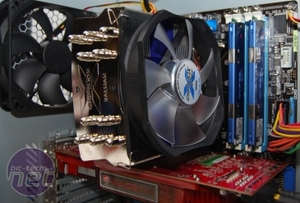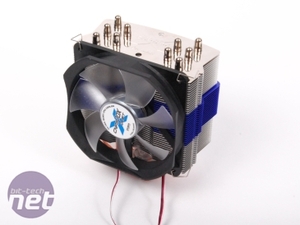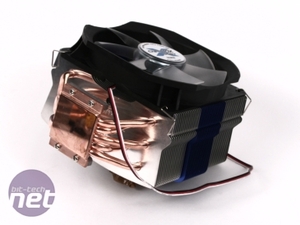Zalman CNPS 10X Quiet
Manufacturer: ZalmanUK Price (as reviewed): £39.99 (inc VAT)
US Price (as reviewed): $58.98 (exc tax)
While the 10X Quiet is essentially the same as the Zalman CNPS 10X Extreme, there are a few differences. The Quiet has a quieter, slower-spinning fan with no blue LED, and Zalman has only anodised a bank of the aluminium cooling fins blue rather than nickel-plate all the fins, as with the Extreme. The Quiet comes with a Fan Mate 2 while the Extreme has a PWM Mate. The Fan Mate 2 is a conventional fan speed controller based on voltage, with less voltage giving the fan less power and therefore forcing it to spin slower.
The Quiet is a large cooler, measuring 130 x 93 x 157mm (W x D x H), and installs in a similarly fiddly way to the Extreme. The manual doesn’t help either, as it unintuitively tries to deal with all Intel socket types at once rather than be more explicit that each socket type requires different parts and assembly procedures.
Once you have deciphered the manual, the two-stage installation process requires you to screw a plastic base into four plastic nuts for LGA1156 – we either ended up with balancing the motherboard on its edge as we held the nut on one side and screwed into it on the other. Once the plastic base is installed, you can use the supplied, viscous Zalman ZM-STG2 TIM to cover your CPU. You then have to remove the clips holding the fan to the cooler, and slot the heatsink into the metal hold-down. You then screw this hold-down into the plastic base, thus clamping the heatsink to the CPU, before re-attaching the fan. If that was tedious to read, just imagine what it was like to actually do it.


Left: like the 10X Extreme, the heatpipes of the Quiet aren't well bonded to the CPU contact plate. Right: The Quiet in situ
Results and Conclusion
As the name implies, the Quiet was very quiet, with the fan hardly audible even with the Fan Mate 2 at full speed; at its lowest speed the fan barely moved. However, the temperatures weren’t great, with a high delta T of 62°C with the fan on full speed, and of 74°C with the fan reduced to 700rpm.While the latter temperature came close to the Tjunction safe thermal threshold of the CPU, it never equalled it - as we were using a hefty overclock and the Quiet is designed for quietness, the test results aren’t as terrible as the first seem. In fact, given that the Quiet cooled our overclocked and overvolted Lynnfield equally as well as the Zalman CNPS 10X Extreme when at full fan speed (and better than the other cooler on test) and yet is cheaper and quieter than the Extreme.
That said, we are concerned that despite the CPU getting hot, the heatsink itself didn’t get particularly warm. The heatpipes don’t look well bonded to the plate, with gaps and blobs of solder; worse still, the top of the contact plate doesn’t clamp down onto the top of the heatpipes especially snugly. This means that heat of the CPU isn’t being dumped into the heatpipes as efficiently as it could, and thus the heatpipes are hampered in their ability to suck heat up themselves and transfer it into the cooling fins. This is also true of the 10X Extreme, so it looks like Zalman needs to look at its new 10X heatsink design again.
Despite the fact the 10X Quiet provides the most potential - given this glaring manufacturing problem we still wouldn't buy it. Of all the things a heatsink can do - the one, fundamental thing it needs to do is to draw away heat effectively.
- Features
- x
- x
- x
- x
- x
- x
- x
- -
- -
- -
- 7/10
- Performance
- x
- x
- x
- x
- x
- x
- x
- -
- -
- -
- 7/10
- Ease of Use
- x
- x
- x
- x
- x
- x
- -
- -
- -
- -
- 6/10
- Value
- x
- x
- x
- x
- x
- x
- x
- -
- -
- -
- 7/10
- Overall
- x
- x
- x
- x
- x
- x
- x
- -
- -
- -
- 7/10

MSI MPG Velox 100R Chassis Review
October 14 2021 | 15:04











Want to comment? Please log in.